With specialty loaves flooding bakeries nowadays, calorie-focused dieters struggle to see past the hype to the facts within. This leaves an open question: Does flavorful sourdough deliver satisfaction with less caloric sting than other options? Read on as we unveil the evidence-based truth around sourdough’s calories and nutrition. So take a fresh look at humble sourdough – your new diet darling may have some old-world roots!
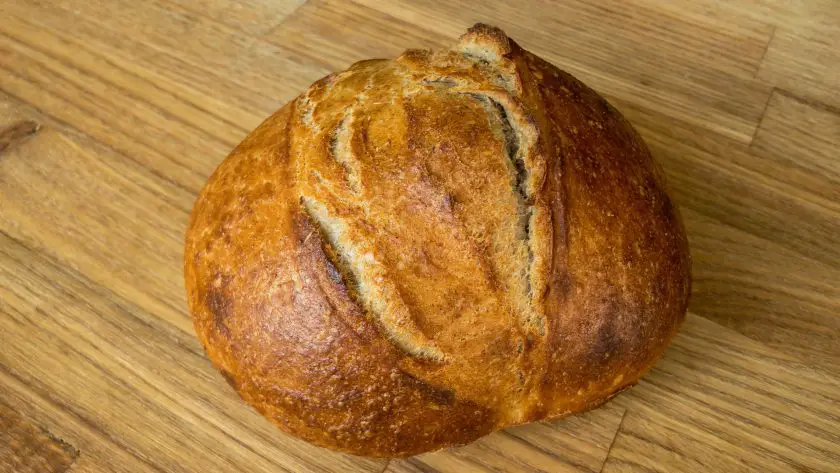
Table of Contents
- How Many Calories in Sourdough Bread
- How to Calculate Sourdough Bread Calories
- Understanding Sourdough and Calories
- Sourdough Bread Nutrition Facts
- Serving Suggestions for Sourdough Bread
- How to Incorporate Sourdough in Your Diet
- Health Benefits of Sourdough
- Comparing Sourdough Nutrition to Popular Breads
- How to Lower Calories in Sourdough Bread
- Making Your Own Low-Calorie Sourdough
- Sourdough Bread and Calories
- Sourdough Bread Calories – FAQs
How Many Calories in Sourdough Bread
The calorie content in sourdough bread can vary depending on the specific recipe and ingredients used.
However, on average, a typical slice of sourdough bread (weighing around 1 ounce or 28 grams) contains approximately 80 to 100 calories.
This estimate can change based on factors like the type of flour used, the size of the slice, and any additional ingredients (such as seeds, nuts, or sweeteners) that might be included in the bread.
Below is a list of sourdough bread recipes, followed by their calorie count.
| Calories per serving | Carbs per serving | |
| Sourdough hot dog buns | 272g | 47g |
| Sourdough hamburger buns* | 218g | 39g |
| Sourdough zucchini bread | 413g | 64g |
| Garlic sourdough bread | 247g | 46gg |
*Whole wheat sourdough hamburger buns have around 25 g of carbs per serving
How to Calculate Sourdough Bread Calories
With sourdough’s surge in popularity, more folks want to know exactly how many calories hide within those bakery-quality loaves.
Luckily, a few easy methods help determine sourdough’s caloric content so you can fit this flavorful fermented favorite into your diet goals.
Check the Nutrition Label
For store-bought sourdough from your grocer’s bakery section, simply read the nutrition label on the packaging. Most major brands now provide complete nutritional information including calories, carbs, protein, and fat per serving size – typically one slice. This takes the guesswork out of tracking your intake.
However, calories can still vary between products depending on the flour blend, starter culture, proofing time, and baking process. Sprouted and whole grain versions pack extra nutrition compared to white sourdough made from refined flour. And artisanal bakeries may provide general estimates but lack precise measuring. So while helpful, sourdough labels only reveal part of the picture.
Use Online Calorie Calculators
If you bake your own sourdough at home or buy from a small bakery, try an online calorie calculator instead. Tools like CalorieKing let you input the exact ingredients and serving size to compute nutritional stats.
For example, two slices of basic sourdough containing white flour, water, salt, and starter culture clocks in around 196 calories with 36g of carbs. Trade white flour for whole wheat and you get 208 calories and 40g carbs. Top with olive oil and that adds another 60 calories per tablespoon.
These calculators offer estimates based on typical recipes but can’t account for every baker’s individual methods. So consider them a helpful benchmark when tracking your homemade loaves.
Weigh Your Slices
For the most accurate home baked sourdough calorie count, weigh your sliced bread directly. Use a kitchen scale to measure the grams per slice then cross reference the mass against a nutrition database like the USDA FoodData Central. This returns incredibly precise calorie and macro counts tailored to that exact portion size of your unique loaf.
Sure, pulling out the kitchen scale for every slice takes effort. But if you’re closely tracking macros or calories for health reasons, it offers foolproof insight. Overtime, the process also helps train your eye to visually estimate reasonable serving sizes.
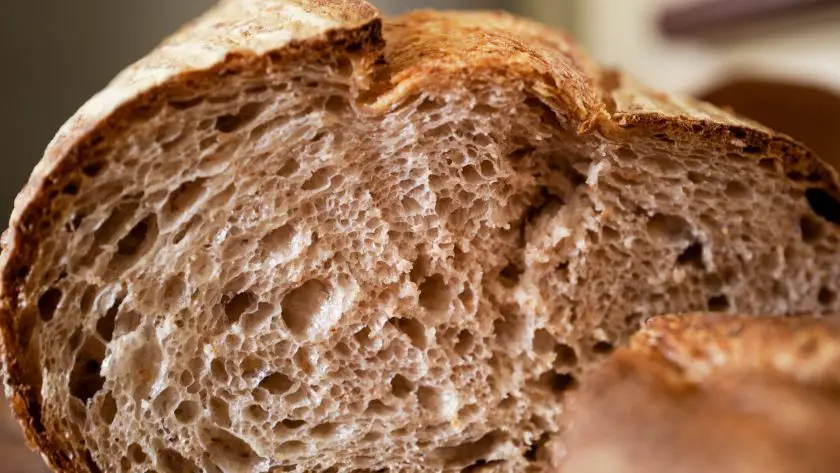
Understanding Sourdough and Calories
Sourdough bread’s recent rise in popularity stems from the COVID-19 pandemic initiating a home baking trend amid lockdowns and yeast shortages, alongside an increasing interest in healthier, more natural food options. Sourdough is a popular choice thanks to its rich flavor and purported health benefits.
But many dieters eye specialty breads warily, concerned about increased calories and carbohydrates. So what’s the real story with sourdough nutrition and calories?
A Lower-Calorie Bread Option
Compared to most commercial breads, sourdough packs nutritional perks with far fewer calories. For example:
| Serving size | Calories | Carbohydrates | |
|---|---|---|---|
| White sandwich bread | 2 slices | 130 calories | 24 g |
| Sourdough bread | 2 slices | 100-110 calories | 18-20 g |
In addition to sourdough delivering plentiful nutrition and fiber with less impact on your daily calorie count.
And with only 2-3 grams of added sugar per slice, sourdough offers functional fuel rather than empty carbs that quickly spike blood sugar. This steadier energy helps curb cravings so you eat less overall.
It’s no wonder nutritionists often recommend sourdough as part of a healthy diet plan for sustainable weight management.
Benefits Beyond Calorie Counting
Focusing solely on calories overlooks sourdough’s many nutritional advantages.
Its long fermentation enriches the bread with probiotics, vitamins, minerals, and antioxidants. The acids produced during sourdough fermentation also increase nutrient absorption capacity.
For example, sprouted whole grain sourdough provides 8-15% of your RDI for selenium, zinc, iron, magnesium, phosphorus, and B vitamins in just two slices. These nutrients boost immunity, energize metabolism, stabilize digestion, improve cognition, and more.
Pretty impressive for such a humble loaf!
Achieving Balance with Sourdough
Like most foods, sourdough offers health benefits in moderation. Two or three slices per day easily fits into a balanced diet and active lifestyle. But for those monitoring carb intake closely, sticking to just a single slice may better align with weight loss or diabetic nutrition plans.
The key is mindful eating. Savor each bite of sourdough to satisfy hunger instead of overindulging out of habit or boredom. Pair sourdough meals with protein and healthy fats to further regulate blood sugar response.
And be sure to account for sourdough’s calories and carbs just as you would for pasta, quinoa, fruit, or any other nutritious treat.
Sourdough Bread Nutrition Facts
With all the chatter of sourdough’s health hype, what exactly lands this loaf a spot among superfoods? A glance at the numbers reveals sourdough’s nutritional advantages.
Here are the nutrition facts for a typical slice of sourdough bread:
| Values | |
|---|---|
| Serving size | 1 slice. 28g |
| Calories | 80-100 calories |
| Fiber | 1-2 g |
| Carbohydrates | 15-20 g |
| Protein | 3-4 g |
| Fat | 0.5-2 g |
| Sugar | <1 g |
| Sodium | 200-400 mg |
All the Fiber, Fewer Calories
Two slices of sourdough provide 3-4 grams of dietary fiber – the highest amount compared to most commercial breads. This indigestible fiber scrubs the digestive tract clean while feeding healthy gut bacteria. The result? Regular bowel movements, balanced blood sugar, lower cholesterol, and reduced inflammation.
And with only 100-110 calories per serving, sourdough fits into weight loss meal plans more easily than calorie-dense refined bread options. You get copious nutrition at a calorie discount compared to sandwiches or toast made from bagels, croissants, or sub rolls.
More Minerals and Micronutrients
Thanks to sourdough’s long ferment, the bread becomes infused with bioavailable micronutrients. Minerals like iron, zinc, magnesium, and phosphorus soak into the bread in readily absorbable forms to nourish the body better.
The ferment also increases B vitamins including folic acid, niacin, riboflavin, and thiamine. This vitamin boost energizes metabolism, fortifies immunity, and keeps the nervous system humming.
So while basic white bread only provides empty calories, nutrient-dense sourdough serves your cells a balanced meal.
Probiotics for Digestive Health
Sourdough’s starter culture brims with lively probiotics to regulate digestion and gut health. These beneficial microbes help transport nutrients, produce vitamins, and keep disease-causing bacteria in check.
Several studies confirm daily sourdough consumption improves digestive wellness, reducing bloating, gas, and gut inflammation. For those with gluten sensitivity, the bacteria even help break down problematic compounds during sourdough fermentation.
Whole Grains Bring Extra Benefits
Opting for whole grain sourdough adds even more benefits via fiber, protein, antioxidants, phytochemicals, and healthy fats from the intact germ and bran. This natural package regulates cholesterol, blood pressure, and blood glucose while protecting cells against disease.
So don’t just reach for standard white sourdough and call it a day. Branch out to whole grain, sprouted, rye, and ancient grain loaves to amplify nutrition across the board!
In today’s processed food landscape, few options pack such a nutritional wallop as humble sourdough using time-honored traditions for flavor and health. This functional food multitasks as the starchy base of a balanced daily diet, brimming with nourishment to benefit your whole being.
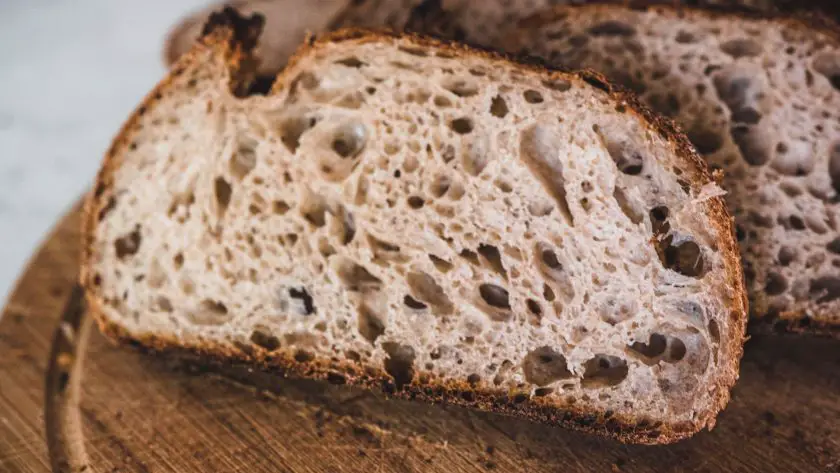
Serving Suggestions for Sourdough Bread
Now that you know the stellar nutrition packed into sourdough, how much should you eat to reap the rewards? Check out these serving tips for enjoying the right portion sizes.
Follow General Bread Guidelines
According to USDA guidelines and daily values, one slice of bread counts as one ounce-equivalent serving from the grains food group. Adults should aim for 5-8 ounce equivalents daily, while children need fewer based on age and activity level.
So if you currently eat 2-3 slices of sandwich bread per day, sourdough fits perfectly into that pattern as a simple swap. Pay attention to serving sizes, and scale intake to align with your individual calorie needs and health goals.
And remember – sourdough’s nutrition does depend somewhat on the recipe. Opt for whole grain and sprouted versions to maximize fiber, protein and nutrients per slice.
Mind Your Carb Counts
For those monitoring carbohydrates closely, two average slices of sourdough provide 36-40 grams, equal to 2-3 carb servings. So diabetics and low-carb dieters may want to limit intake to one slice.
You can also opt for open-faced sandwiches using just one slice per meal. Or consider smaller rolls, sliders, and bites versus large deli-style sandwiches to cut back.
Pair sourdough with veggies, protein and healthy fats at meals to help manage blood sugar response. And be sure to account for all carbs from beverages, sides and treats in your daily totals.
Weigh and Measure For Precision
If tracking your food intake closely, weighing bread helps pinpoint exact serving sizes. Use a kitchen scale and count 28 grams as one ounce-equivalent. For most slicing methods, this equals one slice of bread.
You can also reference nutrition data online to find calorie and carb counts based on gram weights. Just search for “sourdough bread” and input the number of grams actually consumed to see macro totals.
Getting into this habit takes the guesswork out of serving sizes so you know precisely what you’re eating. Over time, your visual judgement of portion sizes will likely improve as well.
Savory Before Sweet
Save any sweet baked treats like French toast, dessert bread pudding or sandwiches with jam for occasional treats rather than daily habit. Focus first on nutritious savory meals to avoid excess sugar and maximize nutrition.
If making French toast or sweet quick breads like banana or zucchini, limit intake to one piece 2-3 times per week. And stick to just a thin schmear of jam or other sweet mix-ins.
Prioritizing more wholesome savory preparations makes it easier to keep sourdough consumption balanced as part of an overall healthy lifestyle.
How to Incorporate Sourdough in Your Diet
Now that you know about sourdough’s stellar nutrition profile, it’s time to work this functional food favorite into your daily diet and menu.
With so many easy, delicious ways to enjoy sourdough, there’s no excuse to miss out on the benefits.
Sourdough for Balanced Breakfasts
Start your day the wholesome way with a sourdough breakfast sandwich with smashed avocado, nut butter, or a sunny side up egg. The fiber keeps you satisfied for hours while the fat and protein provide sustained energy to power your morning.
For special weekend breakfasts, sourdough French toast made from thick slices of sourdough makes a welcome treat. Or turn leftover bread into Overnight Breakfast Casserole with veggies, cheese, and eggs baked to perfection.
Packed with nutrition, sourdough English muffins or bagels with eggs fill you up without weighing you down.
Sandwiches and More for Lunch
When midday hunger hits, sliced sourdough subs in seamlessly to make sandwiches, panini, and melts. Layer cold cuts, cheese, hummus and roasted veggies for fiber-rich sandwiches to enjoy on the go.
Grilled cheese and tomato soup also becomes a gourmet delight when swapping in sourdough. And the bold taste of sourdough shines through in hot melty paninis layered with savory fillings.
For lovely ladies who lunch, tea sandwiches with cucumber, shrimp salad or chicken salad make dainty, nutritious nibbles on sliced sourdough. The options are endless!
Savory Suppers with Sourdough
At dinnertime, take sourdough beyond bread bowls and breadcrumbs by incorporating it into entrées for a touch of added nutrition:
- Make Veggie Pot Pie topped with a baked sourdough crust
- Fry cubed sourdough with garlic and herbs as hearty croutons for soup or salad
- Layer BBQ chicken, sourdough slices and cheese
- Top Shepherd’s Pie or Fisherman’s Pie with mashed potato-slathered sourdough
- Bake sprouted grain sourdough cubes into peppers or eggplants
With so many easy ways to bring more sourdough to the table, you’ll enjoy new favorite weeknight meals and tasty leftovers too.
Health Benefits of Sourdough
Beyond basic nutrition, sourdough shines for its array of feel-good health perks thanks to its live fermentation process. Let’s explore the science-backed benefits that land this ancient bread on the superfood scene.
Probiotics for Digestive Health
Sourdough gets its tangy zing from live cultures like wild yeast and lactobacilli that feed on the natural sugars and starches in flour. These good microbes act as probiotics to balance digestion.
Several studies confirm eating sourdough bread regularly keeps your gut microbiome thriving. The probiotics increase nutrient absorption, transport vitamins through your system, and flush away toxins and waste. They also curb bad bacteria and inflammation linked to gas, bloating, and IBS.
For those avoiding gluten, sourdough may be easier to digest since the long ferment pre-digests wheat proteins associated with sensitivity. The bacteria even generate acids that degrade immune-triggering peptides.
Bettering Blood Sugar Levels
With a low glycemic index and extended release of glucose into the bloodstream, sourdough is less likely to cause sharp spikes and crashes in insulin response. This makes it an excellent choice for diabetics and pre-diabetics concerned about managing blood sugar highs.
The prebiotics in sourdough may also improve insulin sensitivity based on early research. For those without glucose regulation issues, the balanced energy supplies a steady stream of fuel to power your cells.
Supporting Overall Immunity
Beyond housing beneficial bacteria, sourdough undergoes vitamin synthesis and mineral enrichment during fermentation. The abundant micronutrients boost immunity and antioxidant status to combat disease.
Studies specifically link sourdough bread consumption with improved iron levels, even more than whole grain bread. This mineral powers red blood cells to carry oxygen throughout your body keeping organs and muscles energized and healthy.
So biting into sourdough literally infuses a little immune system support into every cell!
Aid for Weight Loss
Sourdough bread can aid in weight loss through several key attributes. It has a lower glycemic index compared to many other breads, leading to slower blood sugar rises and potentially aiding in appetite control. The fermentation process in sourdough enhances digestibility and can increase satiety, helping to reduce overall calorie intake. Sourdough, especially when made from whole grains, is nutrient-dense, offering essential nutrients without excessive calories. Additionally, homemade or artisanal sourdough typically contains fewer preservatives and additives, aligning with a healthier diet. Finally, the acetic acid produced during fermentation may improve blood sugar control, an important factor in weight management.
However, it’s essential to consume sourdough in moderation as part of a balanced diet to effectively contribute to weight loss.
Comparing Sourdough Nutrition to Popular Breads
How does sourdough’s nutrition and digestive properties stack up against regular white bread or whole wheat bread? Let’s explore some key differences.
Versus White Bread
White bread offers pillowy soft familiarity but lacks significant fiber, proteins or micronutrients since the nutritious germ and bran gets stripped away. In contrast, hardy whole grain sourdough retains nutrition and undergoes an extended ferment that further enriches the bread. The tangy, chewy crumb brims with more iron, zinc and B vitamins compared to spongy supermarket white bread.
Sourdough also stabilizes blood glucose thanks to its fibers and acids, whereas white bread causes sharp spikes and crashes that promote cravings and overeating. The probiotic microbes in sourdough additionally balance digestion and gut health compared to white bread containing only yeast.
Versus Whole Wheat Bread
Both whole wheat and sourdough provide valuable fiber for heart and gut health. However, sourdough’s long ferment makes its nutrition more bioavailable than regular whole wheat. The bacteria and yeast produce compounds that increase nutrient absorption and break down problematic proteins. This allows more nutrients to reach your cells efficiently.
Plus, studies confirm greater antioxidant activity in sourdough over whole grain bread, which combats cell damage tied to disease. The probiotics in sourdough also balance digestion to ease common issues like bloating.
While less tangy in flavor, sprouted whole grain breads share similar nutrition and gut-health benefits with sourdough’s fermented process. Still, sourdough’s versatility and distinctive artisanal quality keeps it out front!
Did you know there’s whole wheat sourdough?
The Takeaway
With extended fermentation unlocking more nutrition and digestibility compared to modern bread making, sourdough earns its superfood status. Its fiber feeds good gut bacteria associated with better health outcomes too.

How to Lower Calories in Sourdough Bread
Sourdough’s stellar nutrition profile makes it perfect for healthy diets. But for some, closely monitoring calories remains important for weight goals or conditions like diabetes.
Luckily, easy ingredient swaps and preparation tricks transform hearty sourdough into a lean machine without sacrificing flavor.
Choose Nutrient-Dense Flours
When baking sourdough at home, use a blend of flours lower in carbohydrates like almond, coconut or oat flour. For those tolerating grains, try sprouted whole wheat or alternate whole grains like buckwheat, millet or rye. These provide more nutrition per calorie compared to plain all-purpose white flour. Just stick with the same total flour weight in recipes to minimize adjustments.
Boost Nutrition With Add-Ins
Stir in nutritious mix-ins like ground flax or chia seeds, wheat germ, oats or antioxidant-rich fresh herbs. Top loaves with toasted nuts, seeds or fiber-full fruit before baking too. This further amplifies nutrition without significantly increasing calories.
Alter Baking Style
Instead of standard loaves, shape dough into petite rolls or flatbreads for better portion control. These smaller servings curb overindulging and make it easy to freeze extras. Or skip the rise by baking unleavened sourdough crackers or crispbreads for a crunchy low-carb snack.
Rethink Serving Styles
When enjoying sliced sourdough bread, construct open-faced sandwiches using just a single slice. Pile veggie-centric toppings high for volume and fiber rather than fatty sauces or cheese.
For salad croutons, stick to a sprinkle versus loading on cubes. And keep bread bowls or stuffings focused on lean proteins and produce rather than heavy casseroles.
Balance Your Plate
No matter your preparation method, always pair sourdough with wholesome foods like colorful veggies, leafy greens, lean proteins, nuts, seeds, beans and healthy fats. This guarantees proper nutrition for function and satiation. Moderating bread intake while emphasizing nutrition all around allows for slimming success while still savoring slices.
Making Your Own Low-Calorie Sourdough
Creating a low-calorie version at home allows you to enjoy the distinct taste and benefits of sourdough while keeping an eye on your calorie intake. Here’s a recipe for a healthier, low-calorie sourdough bread:
Ingredients
- 1 cup whole wheat flour (for added fiber)
- 2 cups all-purpose flour (you can substitute with a lower-calorie flour alternative)
- 1 cup water (lukewarm)
- 1 teaspoon salt (use less to reduce sodium content)
- ¼ cup homemade sourdough starter (ensure it’s active and bubbly)
Instructions
- Prepare the Starter: A day before baking, feed your sourdough starter to ensure it’s active. Mix equal parts of flour and water with your existing starter and leave it at room temperature for about 12 hours.
- Mix the Ingredients: In a large bowl, combine the whole wheat flour, all-purpose flour, and salt. Gradually add the water and mix until a rough dough forms. Finally, incorporate the sourdough starter.
- First Fermentation (Bulk Fermentation): Knead the dough gently on a lightly floured surface until it’s smooth and elastic. Place it back in the bowl, cover it with a cloth, and let it ferment at room temperature for 6-8 hours. The dough should roughly double in size.
- Shape the Dough: Turn the dough onto a floured surface and shape it into a round loaf. Be gentle to avoid deflating it too much.
- Second Rise (Proofing): Place the shaped dough into a well-floured proofing basket or on a baking tray lined with parchment paper. Cover it and let it rise for another 2-4 hours.
- Preheat and Bake: About 30 minutes before baking, preheat your oven to 450°F (230°C), ideally with a baking stone or Dutch oven inside. Once the dough has risen and the oven is hot, transfer the dough to the Dutch oven or directly onto the baking stone. Make a few slashes on top of the dough with a sharp knife for proper expansion.
- Baking Time: Bake for about 20 minutes with the lid on (if using a Dutch oven). Then, remove the lid and bake for another 20-25 minutes until the bread has a golden-brown crust.
- Cooling: Let the bread cool on a wire rack for at least an hour before slicing. This rest time allows the bread to finish cooking internally and develop its flavors.
Tips for Lowering Calories
- Use a mix of whole wheat flour and lower-calorie flour alternatives to reduce the overall calorie count.
- Avoid adding sugars or fats to the dough, which can increase calorie content.
- Experiment with different flour types, like oat or almond flour, for variety and potentially lower calories.
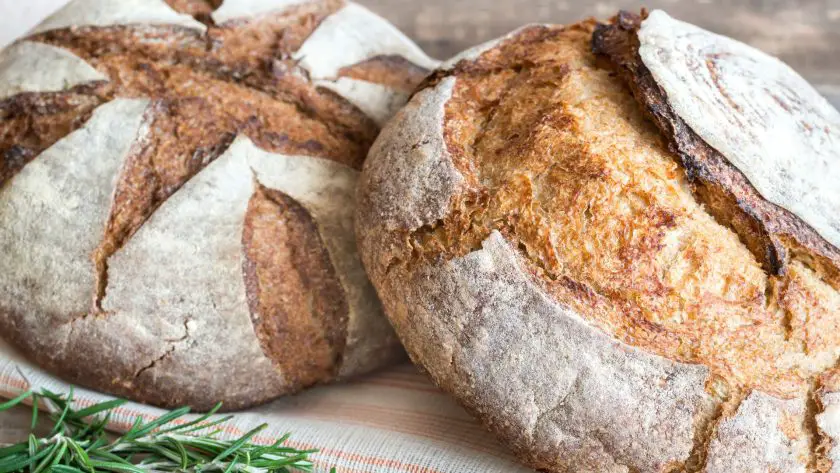
Sourdough Bread and Calories
Depending on the exact recipe, a standard 1 ounce slice provides 80-100 calories and 1-2 grams of fiber – notably less than refined white bread while delivering much more nutrition.
While specialty breads like sprouted whole grain share similar advantages, none match sourdough’s distinctive tang and artisanal flair. So for those monitoring their carb or calorie intake, this classic loaf cleverly cuts back on calories without sacrificing taste or nutrition.
The bottom line? Accounting for serving sizes and smart preparation, nutrient-dense sourdough can be incorporated deliciously into varied diets and lifestyles. So savor the flavor and function of this versatile superfood bread!
Sourdough Bread Calories – FAQs
How many calories is in 1 slice of sourdough bread?
On average, a slice of sourdough bread, weighing about 1 ounce (28 grams), contains approximately 80 to 100 calories. This can vary based on the ingredients and the size of the slice.
Is sourdough bread okay for weight loss?
Yes, sourdough bread can be a suitable option for weight loss. Its lower GI helps control insulin levels, potentially aiding in appetite regulation. Additionally, its higher fiber content contributes to satiety. However, moderation is key, as part of a balanced diet, to effectively aid in weight management.
Is sourdough bread low calorie?
Sourdough bread is not necessarily low calorie due to size and ingredients. However, it’s often considered a healthier choice due to its natural fermentation process and nutrient profile. For a lower calorie option, focus on portion size and choose sourdough made with whole grains or reduced-calorie ingredients.
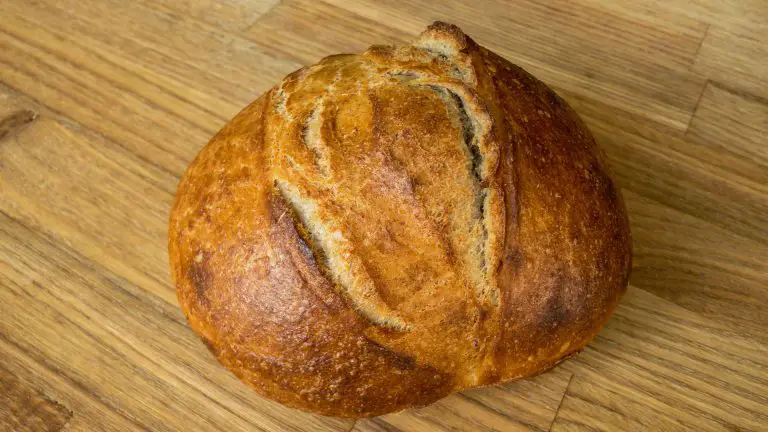
Low Calorie Sourdough Bread Recipe
Here’s a simple recipe for a healthier, low-calorie sourdough bread.
- Total Time: 25. hrs
- Yield: 1 loaf/16 slices 1x
Ingredients
- 1 cup whole wheat flour
- 2 cups all-purpose flour
- 1 cup water
- 1 teaspoon salt
- ¼ cup homemade sourdough starter
Instructions
- A day before baking, feed your sourdough starter to ensure it’s active. Mix equal parts of flour and water with your existing starter and leave it at room temperature for about 12 hours.
- In a large bowl, combine the whole wheat flour, all-purpose flour, and salt. Gradually add the water and mix until a rough dough forms. Finally, incorporate the sourdough starter.
- Knead the dough gently on a lightly floured surface until it’s smooth and elastic. Place it back in the bowl, cover it with a cloth, and let it ferment at room temperature for 6-8 hours. The dough should roughly double in size.
- Turn the dough onto a floured surface and shape it into a round loaf. Be gentle to avoid deflating it too much.
- Place the shaped dough into a well-floured proofing basket or on a baking tray lined with parchment paper. Cover it and let it rise for another 2-4 hours.
- About 30 minutes before baking, preheat your oven to 450°F (230°C), ideally with a baking stone or Dutch oven inside. Once the dough has risen and the oven is hot, transfer the dough to the Dutch oven or directly onto the baking stone. Make a few slashes on top of the dough with a sharp knife for proper expansion.
- Bake for about 20 minutes with the lid on (if using a Dutch oven). Then, remove the lid and bake for another 20-25 minutes until the bread has a golden-brown crust.
Notes
- Let the bread cool on a wire rack for at least an hour before slicing. This rest time allows the bread to finish cooking internally and develop its flavors.
- Use a mix of whole wheat flour and lower-calorie flour alternatives to reduce the overall calorie count.
- Avoid adding sugars or fats to the dough, which can increase calorie content.
- Experiment with different flour types, like oat or almond flour, for variety and potentially lower calories.
- Prep Time: 12 hrs 30 mins
- Cook Time: 45 mins
- Category: bread
Nutrition
- Serving Size: 1 slice
- Calories: 100 kcal
- Sodium: 58 mg
- Fat: 0.2 g
- Saturated Fat: 0.03 g
- Carbohydrates: 21 g
- Fiber: 1 g
- Protein: 3 g



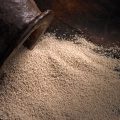
![What Soup Goes Well With Sourdough Bread [15 Best Soups To Try] 81 What soup goes well with sourdough bread [15 best soups to try]](https://www.mydailysourdoughbread.com/wp-content/uploads/2023/06/soups-with-sourdough-120x120.jpg)

